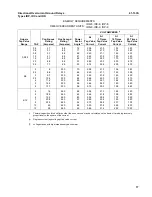
41-133S
5
Directional Overcurrent Ground Relays
Types IRP, IRC and IRD
in each winding at the maximum torque angle for the
directional units used with the 0.5 to 2.5 and 2 to 6
ampere range time overcurrent units. For the direc-
tional units used with the 4-12 ampere range time
overcurrent units the minimum pickup is 1 ampere.
4.7 TYPE IRD RELAY
The IRD relay utilizes a directional unit similar to the
IRC relay and a directional unit and phase-shifting
circuit similar to those in the IRP relay.
The current-polarized directional unit of the IRD relay
operates on residual currents while the poten-
tial-polarized directional unit of the IRD relay oper-
ates on residual voltage and residual current.
For the directional units used with the 0.5 to 2 and 2
to 6 ampere time overcurrent units, the minimum
pick-up of the current polarized unit is 0.5 ampere in
each winding at the maximum torque angle. The min-
imum pick-up for the voltage polarized unit is 1 volt
and 2 amperes with the current lagging voltage by
60°.
For the directional units used with the 4 to 12 ampere
range time overcurrent units, the minimum pick-up is
1 ampere for the current-polarized directional unit
and 1 volt and 4 amperes for the voltage-polarized
directional unit.
5.0 SETTINGS
5.1 TIME OVERCURRENT UNIT (CO)
The time overcurrent unit settings can be defined
either by tap setting and dial position or by tap setting
and a specific time of operation at some current mul-
tiple of the tap setting (e.g. 4 tap setting, 2 time dial
position or 4 tap setting, 0.6 seconds at 6 times tap
value current).
To provide selective circuit breaker operation, a mini-
mum coordinating time of 0.3 seconds plus circuit
breaker time is recommended between the relay
being set and the relays with which coordination is to
be effected.
The connector screws on the tap plate above the
time dial makes connections to various turns on the
operating coil. By placing this screw in the various
tap plate holes, the relay will just close its contacts at
the corresponding current 4-5-6-7-8-10-12 amperes,
or as marked on the tap plate.
Since the tap block connector screw carries
operating current, be sure that the screw is
turned tight.
5.2 INSTANTANEOUS RECLOSING
The factory adjustment of the CO unit contacts
provides a contact follow. Where circuit breaker
reclosing will be initiated immediately after a trip by
the CO contact, the time of the opening of the con-
tacts should be a minimum. This condition is
obtained by loosening the stationary contact mount-
ing screw, removing the contact plate and then
replacing the plate with the bent end resting against
the contact spring. With this change and the contact
mounting screw tightened, the stationary contact will
rest solidly against its backstop.
5.3 INSTANTANEOUS OVERCURRENT UNIT (I)
The only setting required is the pickup current setting
which is made by means of the connector screw
located on the tap plate. By placing the connector
screw in the desired tap, the relay will just close its
contacts at the tap value current.
Since the tap block connector screw carries
operating currents, be sure that the screw is
turned tight.
5.4 DIRECTIONAL UNITS (D)
No setting is required.
5.5 INDICATING CONTACTOR SWITCH
(ICS/I AND ICS/T)
The setting required on the ICS units is the selection
of the 0.2 or 2.0 ampere tap setting. This selection is
made by connecting the lead located in front of the
tap block to the desired setting by means of the con-
necting screw.
5.6 AUXILIARY SWITCH (CS-1 OR TR-1)
No setting required on the auxiliary switch except for
the selection of the required 24, 48, 125 or 250 volt-
age on the tapped resistor. This connection can be
made by referring to Figure 26 (page 40).
!
CAUTION
!
CAUTION




















